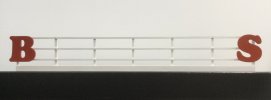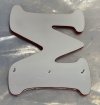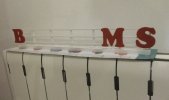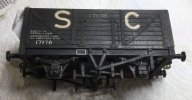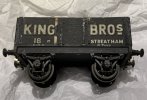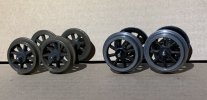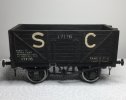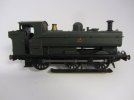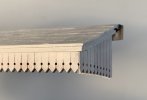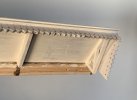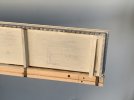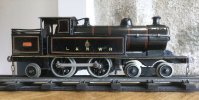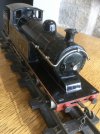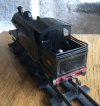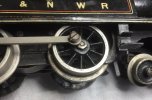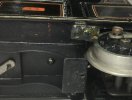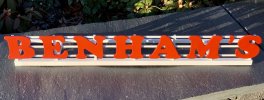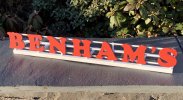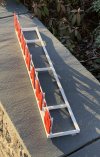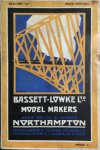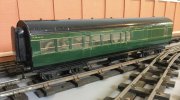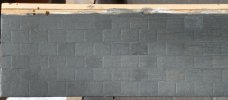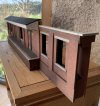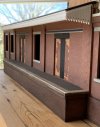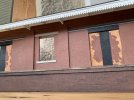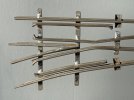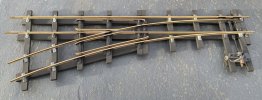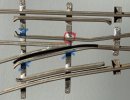A little more on the Stephenson Clarke wagon by Pealling.
Thank you to Overseer for the livery information above. I can add that an illustration from a Gresham Model Railways catalogue is reproduced on the MilbroModelRailways website (Other wagon makers) showing a Stephenson Clarke wagon by Pealling that appears to be in the familiar grey livery.
This morning, I thought I would start looking at the options for replacement wheels. First, simple, job: Take off a couple of the axleguard castings so the existing wheel sets could be dropped out. Except it wasn’t a simple job. The small steel screws that secured the axleguards were heavily corroded and very difficult to shift. On closer examination, there was a deposit of salts around each screw. I wonder if the steel had reacted with the alloy casting or if some water based glue had also been used to hold the axleguards in place? Anyway, I did eventually manage to remove two axleguards without causing any damage.
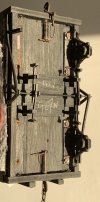
I will have to find four replacement screws, unfortunately.
The above photograph gives a good view of Pealling’s method of constructing dummy brake gear, using card. The price is clearly visible. Also written in pencil, what looks like ‘GE/N’ or possibly ‘Gt7N’. I have no suggestion what this could indicate.
The wagon is probably going to get Bassett-Lowke cast iron wagon wheels, the type sold after WWII and possibly for a few years just pre-war. These wheels are exactly the same diameter as those on the Pealling wagon until this morning. The Bassett-Lowke wheels have a back-to-back measurement of 0.5 mm less and are 1 mm wider. They will fit between the axleguards. The issue is the journals on the Bassett-Lowke wheel sets are of larger diameter and longer. So, to use the Bassett-Lowke wheels, they will have to be removed from their axles (not easy — forced on) and the journals turned down. Other options are still under consideration.
Thank you to Overseer for the livery information above. I can add that an illustration from a Gresham Model Railways catalogue is reproduced on the MilbroModelRailways website (Other wagon makers) showing a Stephenson Clarke wagon by Pealling that appears to be in the familiar grey livery.
This morning, I thought I would start looking at the options for replacement wheels. First, simple, job: Take off a couple of the axleguard castings so the existing wheel sets could be dropped out. Except it wasn’t a simple job. The small steel screws that secured the axleguards were heavily corroded and very difficult to shift. On closer examination, there was a deposit of salts around each screw. I wonder if the steel had reacted with the alloy casting or if some water based glue had also been used to hold the axleguards in place? Anyway, I did eventually manage to remove two axleguards without causing any damage.

I will have to find four replacement screws, unfortunately.
The above photograph gives a good view of Pealling’s method of constructing dummy brake gear, using card. The price is clearly visible. Also written in pencil, what looks like ‘GE/N’ or possibly ‘Gt7N’. I have no suggestion what this could indicate.
The wagon is probably going to get Bassett-Lowke cast iron wagon wheels, the type sold after WWII and possibly for a few years just pre-war. These wheels are exactly the same diameter as those on the Pealling wagon until this morning. The Bassett-Lowke wheels have a back-to-back measurement of 0.5 mm less and are 1 mm wider. They will fit between the axleguards. The issue is the journals on the Bassett-Lowke wheel sets are of larger diameter and longer. So, to use the Bassett-Lowke wheels, they will have to be removed from their axles (not easy — forced on) and the journals turned down. Other options are still under consideration.

